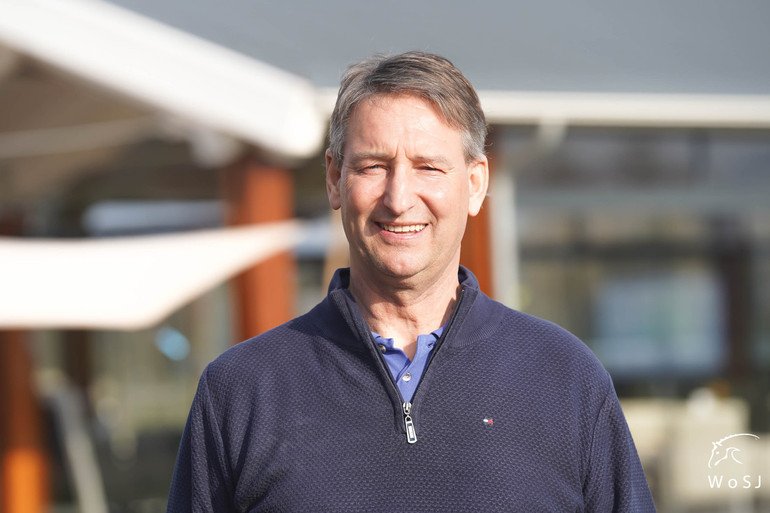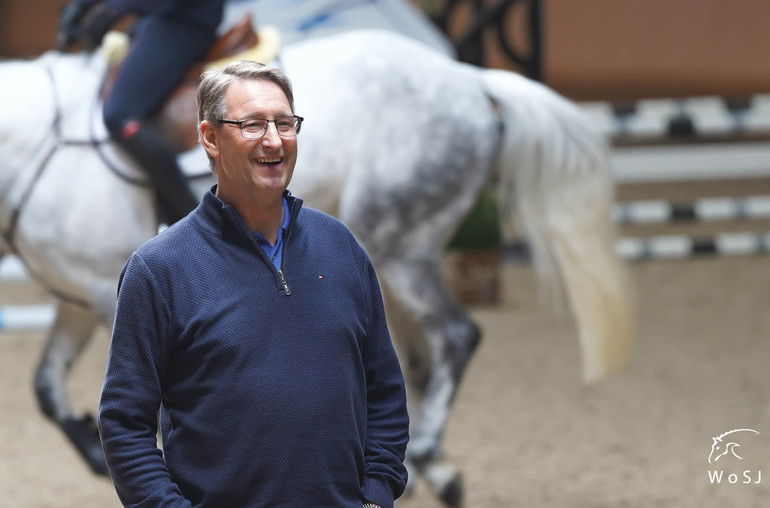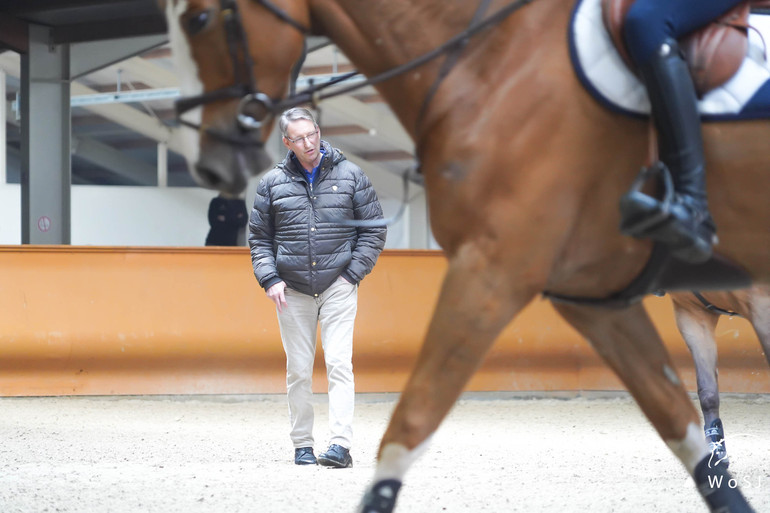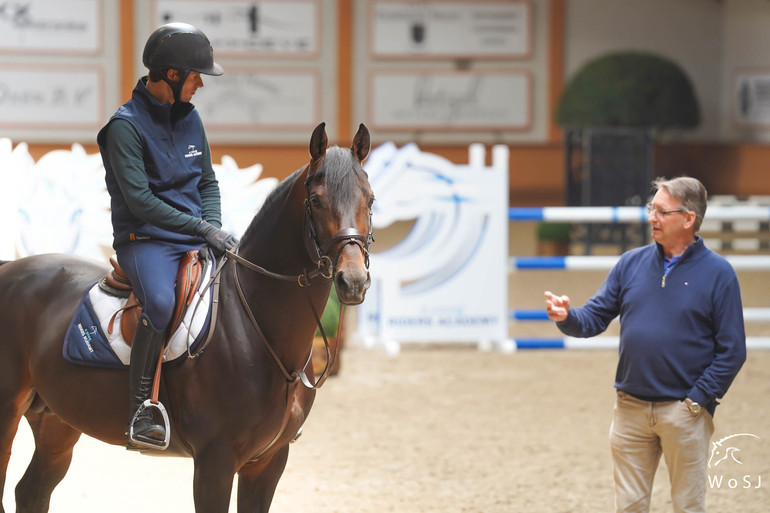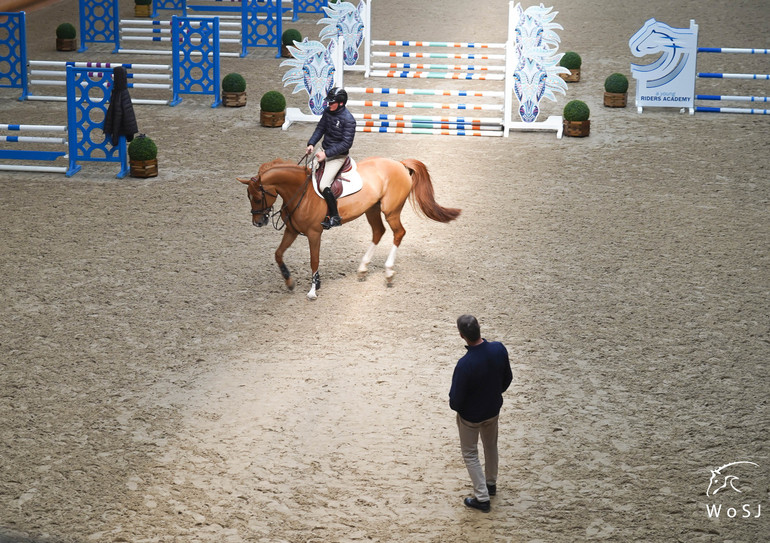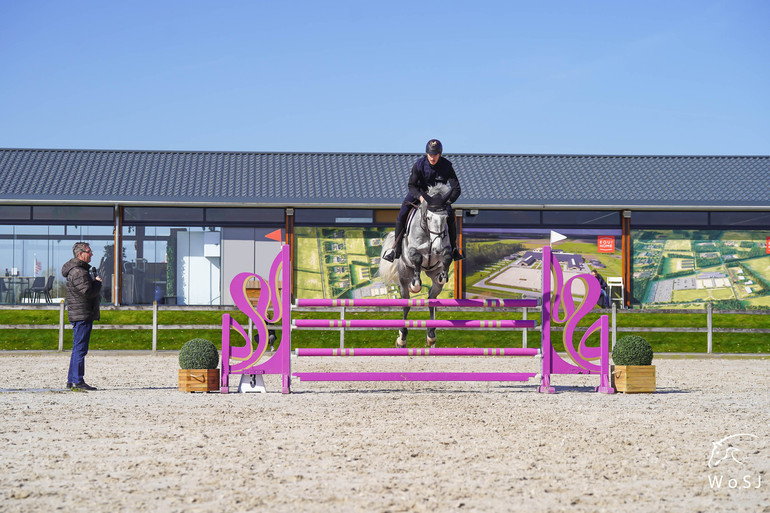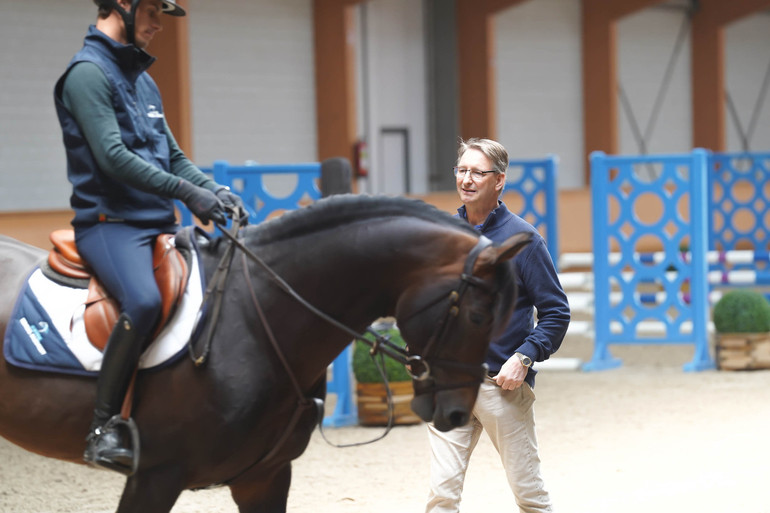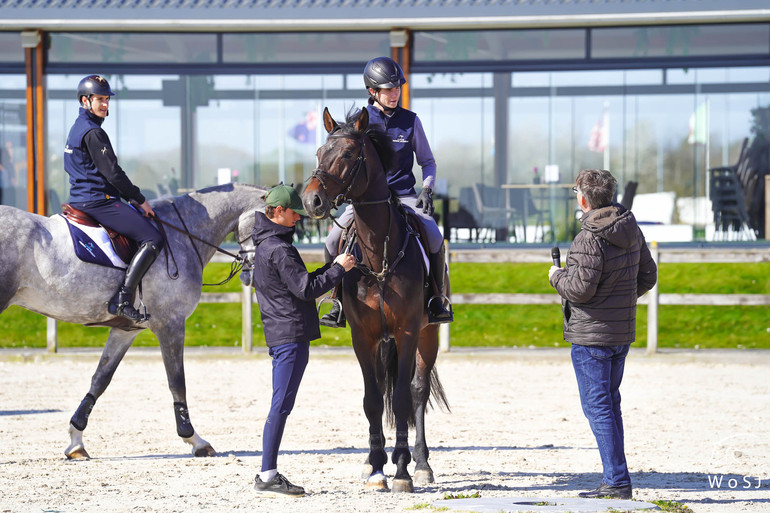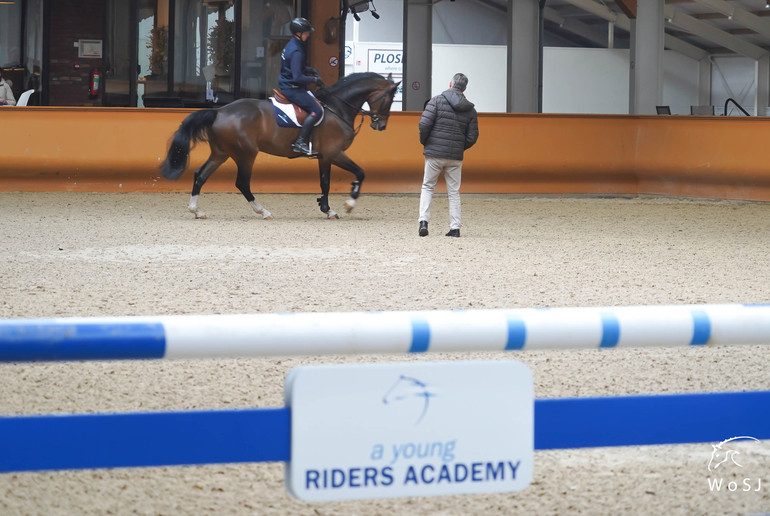Text © World of Showjumping
As the 2023-class of the Young Riders Academy (YRA) gathered for their first training session at Peelbergen Equestrian Centre in the Netherlands, World of Showjumping got to join in. Present was Franke Sloothaak – 1988 and 1996 Olympic Team Champion – to give some advice to the talented young riders that have been selected for the YRA’s 2023-program.
“This will be more about developing little details, points in your riding where you from my view could make your life a little bit easier,” Sloothaak explained. “Be happy that you are part of this group; you should be proud of it and use it to your betterment. The more we look around, the more we get out from ourselves; it is so important to stay open and curious. I train dressage horses too – I know the movement of piaffe, passage, pirouettes – and I would encourage you to be open to this as well. If you ever get a chance to ride a dressage horse; take it – just to have the feeling of the movements.”
“First of all, riding comes from the horse, not from the trainer – it is not that you learn from me; you learn from your horse,” Sloothaak continued. “I can only point out a few things that might make you think differently, but riding is learned from the horse. We have to work with the feeling the horses give us, and that is why it is so important, as a young rider especially, that you have a “schoolmaster” – a good horse that you can learn from. The problem is, we have more and more trainers these days, but these trainers have never sat on a correctly ridden, good, horse. How are these people going to teach others to ride, when they have never felt how it should feel?”
Horsemanship is about being levelled with your horse
“I think the main issue today is that less and less know the basics,” Sloothaak points out. “Horsemanship is about knowing how to treat your horse. As a rider, you are a manager for your horse; looking into the future and seeing what your horse is capable of doing, what kind of work it needs, how you should progress its program – not only with the body, but the mind as well. You have to be levelled with the horse; never above, never under, but levelled.”
I think the main issue today is that less and less know the basics
“We have to give the horses a clear line of where we want to go,” Sloothaak details. “I think a lot of problems start because the horses do not understand what the riders are asking, and that is where the main issues arise. When I do things correctly with a horse, it is easy for it to understand me – in general, riding should not be complicated, it should be easy. The work has to be correct and consequent; normally horses have no problems then.”
You have to be levelled with the horse
“We humans think we are smarter than the horses, but people like to complicate things. Just be clear: Animals only understand black and white, good and bad – us people, we have the problem of liking to discuss things, which makes life complicated,” Sloothaak added. “We want to work together with our horses, and that should be the main goal from the very beginning.”
Improve the movement, improve the body
“These days, the importance of correct flatwork has gotten a bit lost,” Sloothaak continues. “We always have to remember, that as riders, the key is improving our horses and that should be our first aim. The more we can improve our horses, the better their movements and bodies will be, the longer we can keep them sound. That should be our first aim as riders. We know it ourselves; when we feel good in our bodies, we are willing to do more.”
The importance of correct flatwork has gotten a bit lost
“In the end, when you want to reach the top, the basic work has to be correct – both for the body and the mind of the horse,” Sloothaak says. “The most important is that when you improve the movement, you improve the body; you can keep the horses sound longer and I have a lot of examples of this. When you do the right work with the horses, their movements and balance get better, this improves their bodies and they are naturally healthier as a result. Learn to get the right feeling, get impulsion in the horses, get their mind working with you; take the horses your way. Do as little as possible, but as much as necessary – there is a lot of space in between these two opposites, and you have to play with that. In the end, the horse just has to understand what you want; riding is that simple.”
“I try to make riders a little bit more sensitive, more focused on several little details in their own position, to get a control over the movements,” Sloothaak continues. “We have to learn to feel the movement of the horse; if you have the correct feeling of the movement, you can influence it, and when you can influence the movement, you can improve the horse. When your horse is focused and in balance, it is easy to ride a course and work together. Two know more than one; it is so important to create a partnership with your horse, to know how your horse is going to react on different things. Flatwork should be interesting for the horses; it should be us playing with them. As a rider, when I put a message forward to the horse, I want to see what kind of reaction the horse brings back to me. When you know your horse and its reactions, you have more room to play with, you can be quicker in advance, you can react to things. These things riders need to learn about their horses; you have to know what you are going to get. As an example, if you know your horse, you know when you can wait for a fence to come to you, and not panic and pull – because you know how your horse will react. The more room you have to play with, the better you can make it for the horses, the more you are able to help them.”
Inside leg to outside rein
To start with, Sloothaak had each group of horses and riders walk around him on a circle. “I like to have you start with walking on a circle, and in walk and trot only use the inside leg,” he explained. “It is nice when you are indoors; you can have the walls to help you make a better bending of the horse’s body. In walk, first you need the right reaction from the horse: When you put your leg on, your horse needs to react. Teach the horse to be sensitive to your leg – not panic, but accept it. When the horse has a good reaction on the left, then do the same on the right; do both legs individually, not at the same time. When we use both legs at the same time, many times horses get a bit of a “holding their breath”-reaction, and that does not happen with just one leg at the time; horses accept it better.”
Flatwork should be interesting for the horses
“This is about feeling what kind of reactions you get, that is why in walk and trot I always use inside leg to outside rein – inside leg by shoulder-in,” Sloothaak continued. “In canter, I do the opposite: I only use the outside leg, because I want my horse to turn inside, to keep their weight behind. Keeping the outside rein in canter, you can make a circle very small, close to a pirouette, and that is the most collection there is for a horse. This way, they have to lift their front part and sit on their hind legs and that is where you need the most power. However, it is important that the power is created on a straight horse, not with too much bending. When a horse is straight, it has the most power, and we need to practice this. We need the horses to get the power on their stifles – stifles are the weakest part for our horses, because they need them to carry us. Horses don’t use their stifles so much in the nature, but to carry us and to jump, their stifles need to be strong.”
Control but don’t restrict – take the horse with you
“It has to be a game for the horses,” Sloothaak pointed out again and again, highlighting the importance of keeping the work interesting. “It is very important that both the horse and the rider enjoy what they are doing; both have to have fun with it, it has to be playful.”
When horses enjoy what they are doing, everything is easier
“I always say that a competition is a game and I want to be part of it, so I have to play the game. When horses enjoy what they are doing, everything is easier; we help them, there is positivity. It is all about positive impulsion; show your interest, help your horse to get better – we have to make it clear to our horses that we are never against them, we are trying to help them with everything we do. It happens a lot, that people go against; against the movement, against the character, against many things. However, it should never be about being against each other, it should always be about being together with the horse, taking them with you. Daniel Deusser and Katrin Eckermann are perfect examples of riders who always take the horse with them; from young horses to Grand Prix horses, whatever horse they are on, they take the horse with them,” Sloothaak pointed out.
Even though flatwork is about control, it is not about restricting the horse, Sloothaak explains. “Any kind of change you want to do, should be done in a positive, forward movement, never backwards,” he says. “You have to be positive and forward before you can slow down. What we want is a positive reaction, so we have to think in that way. However, at the same time we have to be able to control the movement, to get a better balance, and it always starts behind.”
You have to be positive and forward before you can slow down
“I see many times how people think they need a good mouth, so they change bits…,” Sloothaak reflected. “Sometimes the work can be difficult, but it is important to take the time, and not change the bit and believe that the bit will replace the work. The body needs its time, and a bit cannot do the work. It is the work that makes the body better and this way the feeling in the mouth will improve as well. Maybe at shows you can use another bit, but in normal work, you should not change to a stronger bit to make the work “easier”. You should always keep in mind; do as little as possible, but as much as necessary. And finally, for me, the correct seat for working the horse is the dressage seat. Why are the dressage riders not riding their classes in a light seat? Because it is impossible! Either they are stupid, or we are stupid, but in my opinion, you can only work a horse properly if you have a correct seat.”
Understanding the different approaches
To understand different ways of riding, we have to look into history, Sloothaak points out. “Nowadays, we have to be so thankful to the breeders, they make a hell of a job for us to have so many horses available for the highest level,” he says. “Sometimes, I think good breeding helps the riders, but at the same time it makes the riders lazy: When you have too much talent and quality in the horses, riders might feel like they don’t need to train because they can jump a course easily.”
We have to be so thankful to the breeders, they make a hell of a job for us
“When we look back, the American way of riding is based on thoroughbreds, and these horses don’t need a lot of impulsion, but they need control – that is why you can see the Americans with a light seat with no leg. And when you see the English or Irish riding, that is based on hunting; you simply go in the field, and go! German riding on the other hand is based on big, heavy horses with no blood, but the good thing with this type of horses was that the more you worked with them, the more results you got. For me, in the early days, the best horses were the French; they had a lot of blood, mostly they had good technique, they were not spooky – but that made the French riding lazy. The more the horses can do, the less we as riders have to do! Another way to put it is to say that talent can make you lazy. Talent can help, but without work you can be as talented as you want and there will be no results. Before, when we bought a French horse, people said it was a guarantee of having a horse with a bad mouth. But why was that? By nature, no horse has a bad mouth, but if you don’t work them correctly, of course the horse will be strong. For me, the nicest riding in the early days was the Italian; they had a beautiful style, and I started to question why? Then, I understood that they were not a horse country; they did not produce horses, they went to Germany, Ireland and Netherlands to buy their horses, and bought horses that fitted them.”
Talent can make you lazy
“In some parts, money helps, but a top rider will always find a way,” Sloothaak continues. “I always say that you can dig a top rider underground and he or she will always find a way up. However, if you can buy the best horses, of course it makes life easier. In my early days, when I was working for Paul Schockemöhle with Otto Becker and Ludger Beerbaum in the same barn, I once asked Paul why the other riders always got the best horses. I was frustrated, and Paul said: “We are a professional stable, and you are the best rider – the other riders need the better horses.” That was his way of thinking; when you are a professional, you have to manage many types of horses, you have to be able to bring up all kinds of different horses, all the time coming back to the basics.”
All about the basics
“In the early days, it was difficult to win, and these days, it is difficult to win – so there nothing has changed,” Sloothaak laughs when asked how he sees the evolution of our sport throughout the years. “For sure you can point out differences, but why complicate things? You always have to face the moment, face what is going on, and when you want to be a winner today, you have to face the reality and not think about how things used to be or how they are going to be. Time that has passed is gone and we have to look forward, see what we can do better and improve.”
“However, I do think that the riding in the early days was better, because we could give more time to our horses,” Sloothaak says. “These days, there are so many shows, so much travel, there is not so much time for the horses to grow up. Many people don’t work enough at home, they only go to the shows and compete and think that by that experience the horses get better. Sometimes for the body and for the movement, things would improve with better training and more time – that is why I like to talk with young people about the basics. When your seat is correct and you have a feeling for the movement, then you are able to improve the movement and that will help the balance, make riding easier, help you understand each other. This is what I am trying to do with the young riders; make the basics better.”
* The Young Riders Academy is a program conceived for European talented young show jumpers, under the patronage of the European Equestrian Federation (EEF), with the cooperation of the International Jumping Riders Club (IJRC) and the support of Rolex.
Founded in 2014 by Athenaeum, a non-profit association, the program will give talented riders between the ages of 18 and 23 the chance to get six months of training and boarding at a well-known professional stable. On top of that, professional education in communication, business and economics, veterinary and legal practice related to show jumping. The objective is to develop future champions as well as potential managers of this sport.
1.5.2023 No reproduction of any of the content in this article will be accepted without a written permission, all rights reserved © World of Showjumping.com. If copyright violations occur, a penalty fee will apply.



